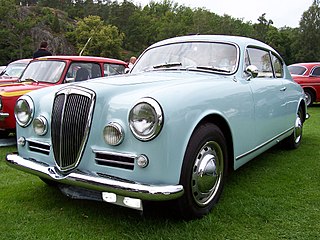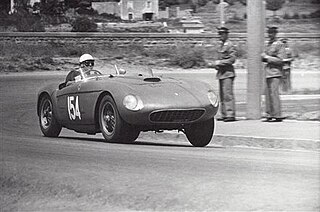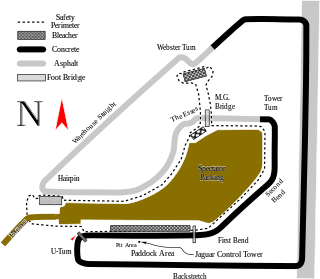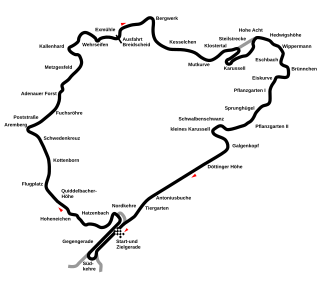
A grand tourer (GT) is a type of sports car that is designed for high speed and long-distance driving, due to a combination of performance and luxury attributes. The most common format is a front-engine, rear-wheel-drive two-door coupé with either a two-seat or a 2+2 arrangement. Grand tourers are most often the coupé derivative of luxury saloons.

The Ferrari 166 S was a sports racing car built by Ferrari between 1948 and 1953, an evolution of its Colombo V12-powered 125 S racer. It was adapted into a sports car for the street in the form of the 166 Inter.

Giulio Cabianca was a Formula One driver from Italy.

The 1954 24 Hours of Le Mans was a 22nd race for Sports Cars, and took place on 12 and 13 June 1954, at the Circuit de la Sarthe, Le Mans, France. It was also the fourth race of the 1954 World Sportscar Championship. The race was won by José Froilán González and Maurice Trintignant driving a Ferrari 375 Plus.

The Ferrari 195 S was a sports racing car produced by Ferrari in 1950. It was an improved version of the 166 MM. The 195 S won Mille Miglia, Coppa della Toscana and Giro delle Calabria.

The Ferrari 250 S was a sports racing car produced by Ferrari in 1952. It was the first in the long lineage of Ferrari 250 road and race cars powered by a ubiquitous 3.0-litre Colombo V12 engine. In 1952 the 250 S won the Mille Miglia and 12 Hours of Pescara. At the Le Mans, the same year, it clocked the fastest race lap time. Only a single example was produced.

The Ferrari 225 S was a sports racing car produced by Ferrari in 1952. It was an evolution over the preceding Ferrari 212 Export with important engine upgrades that greatly improved power output. The model was extensively used in competition, winning many international races. The most important include 1952 Monaco Grand Prix for sports cars, Portuguese Grand Prix, Coppa d'Oro di Sicilia, Coppa della Toscana, Coppa d'Oro delle Dolomiti and many others. It was the final Colombo V12 engine iteration before the 250-family stretched it to 3.0-litres capacity.

The Ferrari 212 Export was a sports racing car produced by Ferrari in 1951–1952. The 212 Exports won Tour de France automobile, Giro di Sicilia, Coppa della Toscana, 10 Hours of Messina and other motor races throughout its career. It was meant to be a sports car available for oversea markets.

Tofane is a mountain group in the Dolomites of northern Italy, west of Cortina d'Ampezzo in the province of Belluno, Veneto. Most of the Tofane lies within Parco naturale delle Dolomiti d'Ampezzo, a nature park.

The Ferrari 250 Monza was a sports racing car produced by Ferrari in 1954. It was a combination of a stretched chassis and body from the line of inline-four-engined racers with an ubiquitous 3.0-litre Colombo V12 engine.

Count Giannino Marzotto was an Italian racing driver and entrepreneur. Marzotto served as President of the Mille Miglia Club, and twice winner of race in 1950 and 1953.

The 23. edizione Mille Miglia was an auto race held on a 992.332 mile (1597 km) course made up entirely of public roads around Italy, mostly on the outer parts of the country on 28–29 April 1956. The route was based on a round trip between Brescia and Rome, with start/finish, in Brescia. It was the 3rd round of the 1956 World Sportscar Championship.

The 1955 Mille Miglia was a 1,000 mile motor race held on a course made up entirely of public roads around Italy, mostly on the outer parts of the country on April 30-May 1, 1955. Also known as the 22. edizione Mille Miglia, the 992.332 mile (1597 km) route was based on a round trip between Brescia and Rome, with start/finish in Brescia. It was the 3rd round of the 1955 World Sportscar Championship and for the Coppa Franco Mazzotti.

The 1954 12 Hours of Sebring was a motor race for sports cars, staged on 7 March 1954 at the Sebring International Raceway, Florida, United States. It was the second race of the 1954 World Sportscar Championship and was the fourth 12 Hours of Sebring. The race was won by Bill Lloyd and Stirling Moss driving an Osca MT4 1450.

The 1954 Mille Miglia, was a motor race open to Sports Cars, GT cars and Touring Cars. It was the 21st Mille Miglia and the third race of the 1954 World Sportscar Championship. The race was held on the public roads of Italy on 2 May 1954 using a route based on a round trip between Brescia and Rome, with the start and finish in Brescia. It was won by Alberto Ascari driving a Lancia D24.

Enrico Anselmi was an Italian racing driver, who made a name for himself racing Lancias in the early 1950s.

The 4. Internationales ADAC 1000 Kilometer Rennen Nürburgring took place on 1 June, on the Nürburgring Nordschleife,. It was also the fourth round of the F.I.A. World Sports Car Championship, which was running to new regulations introduced at the beginning of the season.

The VI. Internationales ADAC 1000 Kilometer Rennen took place on 22 May, on the Nürburgring Nordschleife,. It was the fourth round of the F.I.A. World Sports Car Championship. This was also the third round of the FIA GT Cup.

The Ferrari 250 MM was a sports racing car produced by Ferrari in 1953. After the initial racing successes of the 3.0-litre Colombo V12 engine, introduced in the 250 S one-off, Ferrari produced a serial racing model. It is best recognisable for the distinctive closed berlinetta bodywork by Pinin Farina. The "MM" in its name stood for the Mille Miglia race.

Coppa della Toscana was a sports car race held on the roads of Tuscany, through Livorno and Florence, between 1949 and 1954.
























